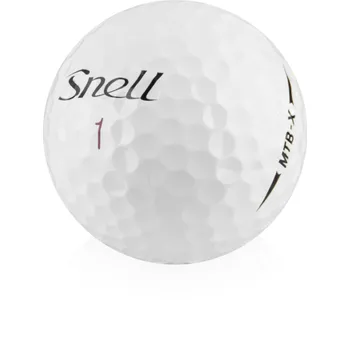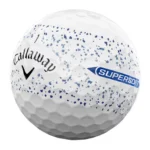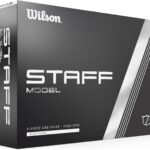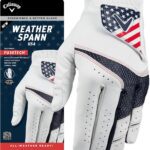What makes Snell balls different?
Snell is a direct-to-consumer brand that seeks to deliver tour-level performance without the usual premium price. Behind it is Dean Snell, an engineer with more than 40 golf ball patents, cited as the co-inventor of the Pro V1 and instrumental in developing the first 5-layer balls after his stints at Titleist and TaylorMade. What I find most compelling is this blend of real R&D with a lightweight structure: it translates into a very solid price/performance ratio.
Another idea that I find practical: Snell guides the choice by your actual distance with the 7 iron, instead of asking you to guess your swing speed. It's a tangible criterion that any player can measure on the course or in a simulator.
Snell 2025 range: PRIME 2.0, PRIME 3.0, PRIME 4.0 (and Get Sum)
Quick summary by distance with 7 iron:
- PRIME 2.0: up to ~125 yd
- PRIME 3.0: 125–165 yd
- PRIME 4.0: 165+ yd
- Get Sum: soft and economical alternative
PRIME 2.0 — 2-piece with urethane cover
A rare offering on the market: a two-piece, but with urethane. It's designed to provide short control and a soft feel for those who don't go over ~125 yards with the 7-iron. I like it because it "democratizes" urethane: you can feel grip on the green without paying the premium price.
For whom: slow-to-mid-speed players who want ease of release and more help in the short game.
PRIME 3.0 — 3 pieces for most
Designed for the general golfer. Medium compression (around 80–85), medium-high spin on irons, and consistent control around the green thanks to a modern urethane cover. If you're a mid-handicapper looking for balance, this is the sweet spot.
For whom: who hits the 7-iron between 125 and 165 yards and wants a balance between distance, control and feel.
PRIME 4.0 — 4-piece, full performance
Optimized for hitters exceeding ~165 yd with the 7. Fast core and multi-layer design to maintain low spin to the driver and Increase control with irons and wedges. It offers the highest performance ceiling if you accelerate the stick easily.
For whom: high swings that seek penetrating flight to the driver and maximum versatility in scoring clubs.
Get Sum — the gateway
Soft ionomer, stable flight, and low spin on the driver. Less bite than urethane on the green, but very pleasant to putt with, and at a reasonable price.
For whom: who wants softness, tolerance and paying less while progressing.
Mini fitting: choose your Snell with the 7 iron (in 2 steps)
- Measure your actual distance with the 7 iron. Field, measured range, or simulator are fine. Stick to your usual flight distance, not the best of the day.
- Cross with the table:
- Up to 125 yd → PRIME 2.0
- 125–165 yd → PRIME 3.0
- 165+ yd → PRIME 4.0
Tip: Compare two models over 9 holes (e.g., 3.0 vs. 4.0). Observe height, green braking, and putter feel.
Snell vs. Premium (Pro V1, TP5, Chrome Soft): What can you expect?
Snell's goal is to offer a urethane cover, spin control, and tour-like feel at a lower price. In mid- and high-profiles, PRIME 3.0 and 4.0 compete very well in controlling irons and wedges, with a stable driver and solid putting feel. PRIME 2.0 fills a gap that almost no one addresses (a two-piece urethane cover), which is why it's a good fit for slow-to-mid-speed players.
Durability, spin with wedges and feel when putting
- Urethane (PRIME): more grip on short strokes and a pleasant “sticky” feeling.
- Multi-layer design (3.0/4.0): helps keep the spin down on the driver and raise it on the irons, where it really adds value.
- Ionomer (Get Sum): Very soft and easy feel, with less bite on the green but great forgiveness and price.
Prices and where to buy them in Spain + customization
You can buy them from the official store or on marketplaces with trial packs, volume discounts, and customization options. My practical recommendation: first define your model with the mini fitting and then look for the best price/pack on your usual marketplace.
Quick table of models (key features)
| Model | Parts | Deck | Profile by 7-iron | Key Notes |
|---|---|---|---|---|
| PRIME 2.0 | 2 | Urethane | Up to 125 yd | Democratizes urethane; focus on feel and short |
| PRIME 3.0 | 3 | Urethane | 125–165 yd | Medium compression; overall balance |
| PRIME 4.0 | 4 | Urethane | 165+ yd | Low spin on the driver; maximum control |
| Get Sum | 2 | Ionomer | — | Gentle and forgiving; affordable price |
Frequently Asked Questions
Which one should I use if I hit the 7-iron at 140 yards?
Start with PRIME 3.0; if you're looking for a more penetrating flight or often play in the wind, try 4.0 as well.
Does a 2-piece urethane ball really stop on the green?
Yes. The cover makes a difference on short strokes: you'll notice more grip compared to an equivalent ionomer.
Why use distance with the 7-iron instead of swing speed?
Because it's a real, easy-to-measure indicator that correlates well with your impact profile and spin needs.
Are there trial and customization packages?
There are usually packs and printing options; if you're torn between two models, buy a mixed pack and decide on the spot.
Which model is for me?
- I want maximum control and easy gameplay → PRIME 2.0
- I'm looking for total balance (medium handicap) → PRIME 3.0
- I accelerate the stick and want a performance ceiling → PRIME 4.0
- I prefer to save and prioritize softness → Get Sum
Snell's proposal makes perfect sense: pedigree engineering and a very practical approach to choosing. If you nail the model with the mini fitting, it's easy to achieve "serious" performance without breaking the bank.










